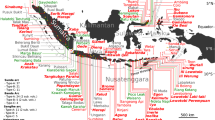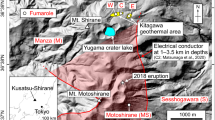Abstract
Natural gas and oil fields, commercially exploited since the 1950s, are distributed in the zonal area facing the Sea of Japan in north-east Japan. We report here measurements of the 3He/4He ratios in 27 CH4-rich natural gases obtained from commercial oil and gas wells in the area. We observed extraordinarily high 3He/4He ratios, up to 8.65×10−6, in gases from wells drilled into deep reservoirs in volcaniclastic rock formations, the so-called ‘Green Tuff’ (Fig. 1). These values are almost identical to those of volcanic fumaroles in the Japanese Islands. In contrast, gases in shallower sedimentary rock reservoirs have low 3He/4He ratios with a minimum value of 0.3×10−6. These low values are similar to those of natural gases originating from biological materials. This suggests that the formation of natural gas reservoirs in the volcaniclastic rock may be attributed to large-scale magmatic activities which occurred in the middle Miocene.
This is a preview of subscription content, access via your institution
Access options
Subscribe to this journal
Receive 51 print issues and online access
$199.00 per year
only $3.90 per issue
Buy this article
- Purchase on Springer Link
- Instant access to full article PDF
Prices may be subject to local taxes which are calculated during checkout
Similar content being viewed by others
References
Matsuda, T., Nakamura, K. & Sugimura, A. Tectonophysics 4, 349–366 (1967).
Hunt, J. M. Petroleum Geochemistry and Geology, 617 (Freeman, San Francisco, 1979).
Magara, K. J. Jap. Ass. Petrol. Technol. 32, 1–8 (1967).
Landes, K. K., Amoruso, J. J., Charlesworth, L. J. Jr, Heany, F. & Lesperance, P. J. Bull. Am. Ass. Petrol. Geol. 44, 1682–1691 (1960).
Welhan, J. A. & Craig, H. Geophys. Res. Lett. 6, 829–831 (1979).
Lilley, M. D. et al. Nature 300, 48–50 (1982).
Hekinian, R., Chaigneau, M. & Cheminee, J. L. Nature 245, 371–373 (1973).
Moore, G., Batchelder, J. N. & Cunningham, C. G. J. Volcanol. geotherm. Res. 2, 309–327 (1977).
Karzhavin, V. K. & Vendillo, V. P. Geochem. Int. 7, 797–803 (1970).
Craig, H. & Lupton, J. E. The Sea Vol. 7 (ed. Emilani, C.) 391–428 (Wiley, New York, 1981).
Aldrich, L. T. & Nier, A. O. Phys. Rev. 74, 1590–1594 (1948).
Kamenskiy, I. L., Yakutseni, V. P., Mamyrin, B. A., Anufriyev, S. G. & Tolstikhin, I. N. Geochem. Int. 8, 575–589 (1971).
Sano, Y., Tominaga, T., Nakamura, Y. & Wakita, H. Geochem. J. 16, 237–245 (1982).
Urabe, A. thesis, Univ. Tokyo (1982).
Nagao, K., Takaoka, N. & Matsubayashi, O. Earth planet. Sci. Lett. 53, 175–188 (1981).
Craig, H., Lupton, J. E. & Horibe, Y. in Terrestrial Rare Gases (eds Alexander, E. C. & Ozima, M.) 3–16 (Japan Science Society Press, Tokyo, 1978).
Halloway, J. R. Yb. Carnegie Instn Wash., 771–775 (1975).
Tsunakawa, H. thesis, Univ. Tokyo (1981).
Sugi, N., Chinzei, K. & Uyeda, S. Geodynamic Ser., Am. geophys. Un., geol. Soc. Am. (in the press).
Author information
Authors and Affiliations
Rights and permissions
About this article
Cite this article
Wakita, H., Sano, Y. 3He/4He ratios in CH4-rich natural gases suggest magmatic origin. Nature 305, 792–794 (1983). https://doi.org/10.1038/305792a0
Received:
Accepted:
Issue Date:
DOI: https://doi.org/10.1038/305792a0
This article is cited by
-
Source and distribution of mercury in natural gas of major petroliferous basins in China
Science China Earth Sciences (2020)
-
Origin of methane-rich natural gas at the West Pacific convergent plate boundary
Scientific Reports (2017)
-
Helium and methane sources and fluxes of shallow submarine hydrothermal plumes near the Tokara Islands, Southern Japan
Scientific Reports (2016)
-
Helium and argon isotope geochemistry of natural gases in China’s petroliferous basins
Chinese Journal of Geochemistry (2011)
-
Natural gas geochemistry and its origins in Kuqa depression
Science in China Series D: Earth Sciences (2008)
Comments
By submitting a comment you agree to abide by our Terms and Community Guidelines. If you find something abusive or that does not comply with our terms or guidelines please flag it as inappropriate.



